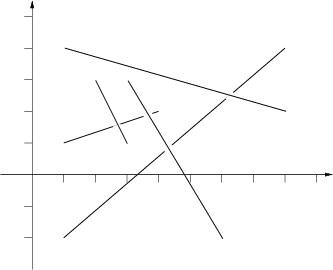Segment set

There are two different commands described in different format shown below:
P x1 y1 x2 y2 - paint a segment whose coordinates of the two endpoints are (x1,y1),(x2,y2).
Q k - query the size of the segment set which contains the k-th segment.
k is between 1 and the number of segments in the moment. There is no segment in the plane at first, so the first command is always a P-command.
1 10 P 1.00 1.00 4.00 2.00 P 1.00 -2.00 8.00 4.00 Q 1 P 2.00 3.00 3.00 1.00 Q 1 Q 3 P 1.00 4.00 8.00 2.00 Q 2 P 3.00 3.00 6.00 -2.00 Q 5
1 2 2 2 5
这题非常水。可是对于高中数学没学好或者像我这样的遗忘到差点儿相同的群体来说。太纠结了。
关键点在于证明两线段是否有连接关系,比方交叉。顶点同样,都算连接
因为遗忘的差点儿相同了。就网上暂时复习了向量积。花了不少时间才消化KO。。
事实上网上的都是标准说法,对于我们这样的不喜欢看书的孩纸来说是天书。所以我把这抽象化的东东用日常一些的语言解释一遍。
假如两线段的两顶点各自是ab和cd,要么证明他们平行且有重叠,重叠就是说当中一线段有顶点在还有一线段中。或者证明他们没有平行之后向量ab在向量ac和向量ad之间,同一时候向量ca在向量ca和向量cb之间。看图。。
从途中能够看到,红色箭头是不符合cd在ca与cb中间的,这就是为什么要两个线段的端点都要取出来验证了,还有就是平行可是不共线,或者平行共线可是由于是线段不相连,所以不能算连接,以下说公式。。。
由于线段A(x1,y1,x2,y2)(x和y表示两个顶点的坐标)斜率L=(y2 - y1)/(x2 - x1)如果要求的是ac与ad的斜率差,那么就是Lac-Lad。然后把公式代入再展开就得到了我代码中dd函数里面的公式,它是用来求斜率差值的。而里面的cmp函数中用dd函数求了4次,这是由于要直接证明ab在ac和ad中间不简单。那么换一方案,直接比較斜率差值,就像上图中左下角的那个图,求出ac和ad的斜率差值还有bc和bd的斜率差值。如果你把线段的斜率用图画出来,你会发现两个差值相乘能推断ab和cd是否交叉。我画个图得了。
。。
这样就攻克了ab与cd存在交叉可是ab太短了没办法从cd中间插过去的问题- -。确定插过去了是cmp函数中d1*d2和d3*d4都小于零的前提,d1*d2是保证ab插过cd,d3*d4是保证cd插过ab,咳咳咳。太邪恶了,baby你懂了没?
总述一下,先考虑平行问题,平行情况下是否有重叠。然后是可能存在交叉的问题,推断好ab从cd中间穿过且ab够长,同一时候cd对ab也要推断一次,这样就能够AC了
注意:数据类型要弄好,由于int会把double的小数位去掉。1.1会变成1,咳咳。太可恶了。就是这个WA我到死。。总之,这个题非常经典。我是这么觉得的
#include <iostream>
#include <cstdio>
#include <cstring>
using namespace std;
struct node
{
double x1,x2,y1,y2;
}s[1111];
int f[1111],num[1111];
double cc=1e-7;
int Find(int x)
{
return f[x]=(f[x]==x?x:Find(f[x]));
}
void Union(int x,int y)
{
x=Find(x);
y=Find(y);
if(x==y)return;//已经在一个集合中就不要反复了
f[x]=y;
num[y]+=num[x];//联系两个线段集合的时候顺便把集合中线段数量集中起来
}
double Max(double a,double b)
{
return a>b?a:b;
}
double Min(double a,double b)
{
return a<b?a:b;
}
double dd(double x1,double y1,double x2,double y2,double x3,double y3)//两线段的斜率差
{
return (x2-x1)*(y3-y1)-(y2-y1)*(x3-x1);
}
int ddd(double x1,double y1,double x2,double y2,double x3,double y3)//共线情况下是否有重叠
{
if(Max(x1,x2)>=x3&&Min(x1,x2)<=x3&&Max(y1,y2)>=y3&&Min(y1,y2)<=y3)
return 1;
return 0;
}
int cmp(node a,node b)
{
double d1,d2,d3,d4;
d1=dd(a.x1,a.y1,a.x2,a.y2,b.x1,b.y1);
d2=dd(a.x1,a.y1,a.x2,a.y2,b.x2,b.y2);
d3=dd(b.x1,b.y1,b.x2,b.y2,a.x1,a.y1);
d4=dd(b.x1,b.y1,b.x2,b.y2,a.x2,a.y2);//cout<<d1<<d2<<" "<<d3<<d4<<endl;
if(d1*d2<0&&d3*d4<0)return 1;//cout<<"X"<<endl;//斜率差一正一负能够得出两不共线线段交叉。上面有本人的个人看法说明
if(d1==0&&ddd(a.x1,a.y1,a.x2,a.y2,b.x1,b.y1))return 1;//cout<<"A"<<endl;//共线的时候看看是否有重叠
if(d2==0&&ddd(a.x1,a.y1,a.x2,a.y2,b.x2,b.y2))return 1;//cout<<"S"<<endl;
if(d3==0&&ddd(b.x1,b.y1,b.x2,b.y2,a.x1,a.y1))return 1;//cout<<"D"<<endl;
if(d4==0&&ddd(b.x1,b.y1,b.x2,b.y2,a.x2,a.y2))return 1;//cout<<"F"<<endl;
return 0;
}
int main (void)
{
int t,n,i,j,k,l;
char c;
scanf("%d",&t);
while(t--&&scanf("%d",&n))
{
for(i=0;i<1111;i++)f[i]=i,num[i]=1;
l=0;
while(n--)
{
scanf("%*c%c",&c);
if(c=='P')
{
scanf("%lf%lf%lf%lf",&s[l].x1,&s[l].y1,&s[l].x2,&s[l].y2);
for(i=0;i<l;i++)//与之前记录的全部线段匹配连接关系
if(cmp(s[i],s[l]))//假设有连接
/*cout<<"A"<<endl,*/Union(i,l);//并查集把线段联系起来
l++;
}else
{
scanf("%d",&k);
printf("%d
",num[Find(k-1)]);
}
//for(i=0;i<l;i++)cout<<num[i]<<" ";cout<<endl;
}
if(t)puts("");//妈啵的,这里没写PE了
}
return 0;
}

